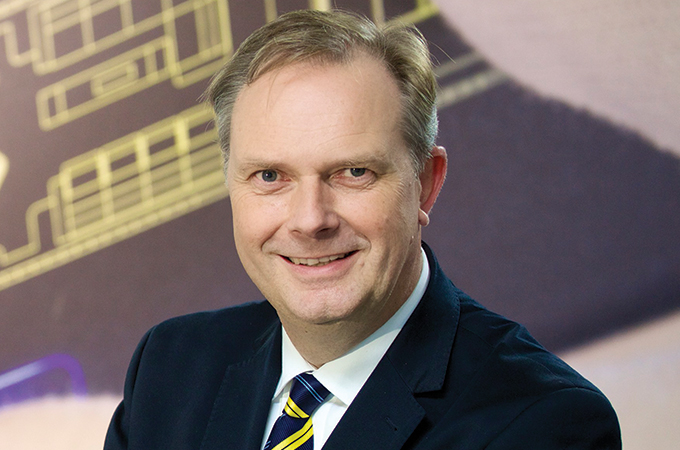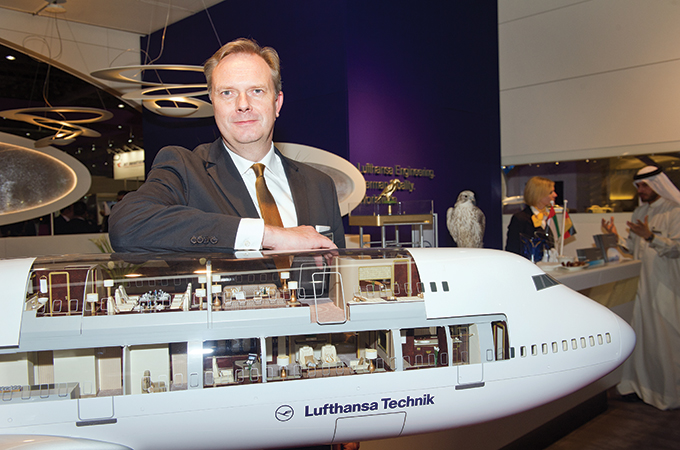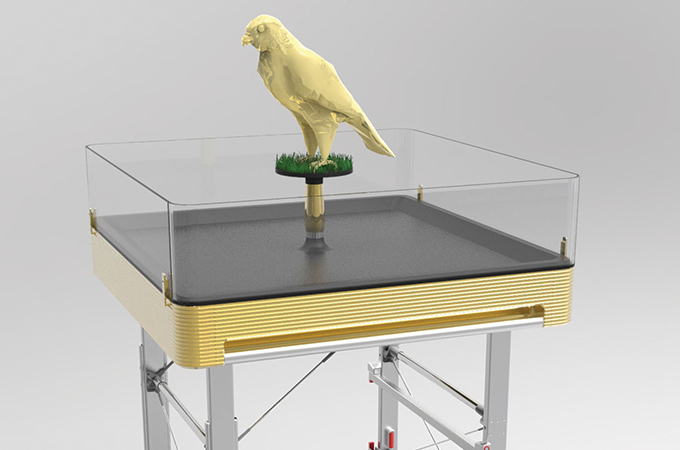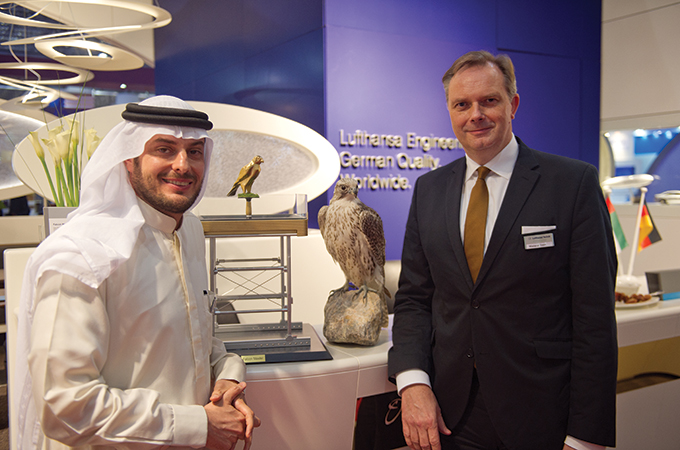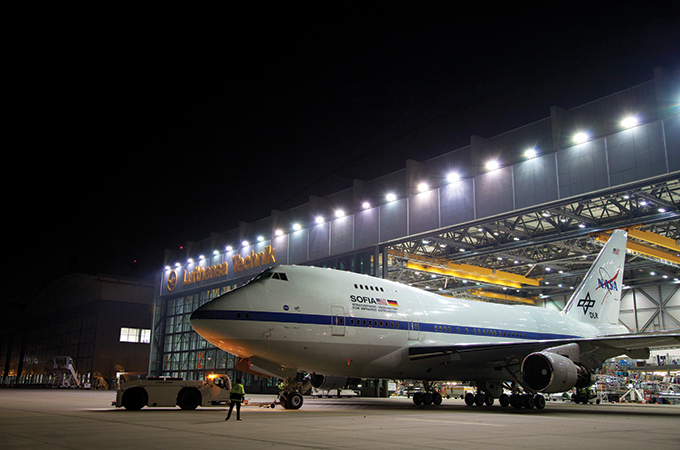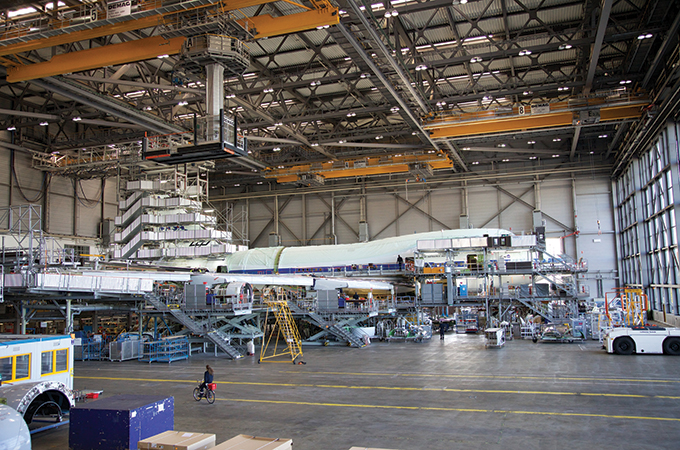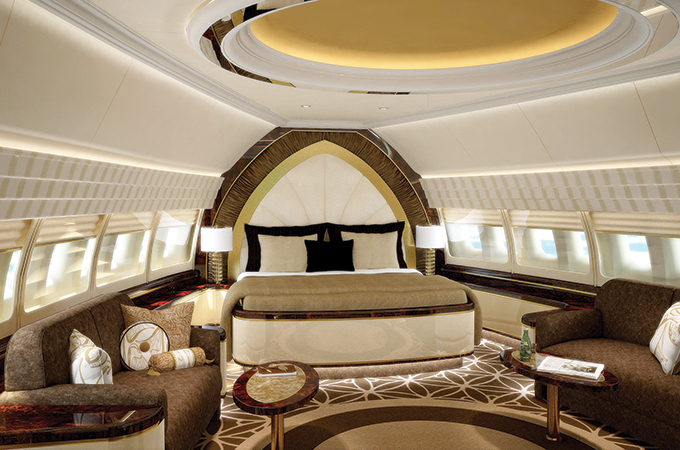Winter 2015
To keep an aircraft flying, there is a crew that the passenger sees and a vast team of supremely skilled professionals that they will never meet. These are the “behind the scenes” people that modify, support and maintain the aircraft.
All are good, but second to none is Lufthansa Technik Group, the technical and engineering arm of Germany’s renowned national carrier.
Wieland Timm, Executive Director Sales, VIP and Special Mission Aircraft for Lufthansa Technik, is justifiably proud of the company’s long association with what is probably the most famous passenger aircraft in the history of aviation: the Boeing 747, also known as the “Jumbo jet”.
Lufthansa started the first interior completion of a Boeing 747, a 747SP (special projects) model, on the request of a Middle East government customer in the mid-80s. Since then, it has completed 17 head-of-state 747 aircraft including the 747SP, 747-300 and 747-400 models and has additionally performed a large number of major modifications or refurbishments on the Jumbo family.
Lufthansa was, as early as 1970, the first European customer for the 747 and the group’s wealth of experience and accumulated knowledge of the jet makes Lufthansa Technik the natural partner for a successful market introduction of the latest Jumbo generation, the 747-8. Lufthansa heavily influenced the development of the successful Boeing model at the end of the 1980s and both maintained and overhauled Lufthansa’s 747-400s (even now there are more than 30 in service) and their engines for almost 20 years.
Now, with the phased replacement of the 747-400 with the latest 747-8, two decades of accumulated experience is being carried forward to the newest Jumbo generation.
747 EXPERTISE
“The Middle East is the biggest market for our VIP services,” Timm tells Arabian Knight. “We modified the first aircraft for this region in 1970. The customer base has grown consistently over the years and we have become the acknowledged experts on 747s.”
Timm observes that the feedback from the Lufthansa group to Boeing concerning the design and looks of an aircraft has always been welcomed. “We presented our thoughts to Boeing, and the Dash 8 is an aircraft that has been influenced by Lufthansa.”
Lufthansa has been a launch partner many times in its 50-year jet services history. It provides expert assistance from the very beginning and helps to turn the vision of a new aircraft into a working, profitable and enduring reality by taking part in the design processes, thus optimising later maintenance operations. “We support a constructive dialogue between all partners involved, thus helping to foresee problems and mobilising all our experience to avoid them,” says Timm.
At the 2014 Middle East Business Aviation (MEBA) show in Dubai, UAE, Lufthansa Technik exhibited a model of the 747-8, the third-generation of the 747, which has a lengthened fuselage, redesigned wings and improved efficiency.
“Up to now, we have completed seventeen 747s – from the SP, 100, 200, 300, and 400 – and the Dash 8 will surely follow. We are currently outfitting two heads-of-state aircraft, and I am sure we will get more,” he says.
Lufthansa Technik also has an extensive package for in-service solutions, which is the group’s main business for commercial airlines.
The latest product in Lufthansa Technik’s service portfolio for the 747-8 is its aircraft production inspection programme (APIP), an independent service for VIP customers, airlines and leasing companies.
“If a customer is using this large type of aircraft, they will need this type of service. We currently have seventy 747s under service contracts, both VIP and commercial,” Timm says, pointing out that the client base for 747 aircraft is huge. “It is a typical head-of-state aircraft, for example the US government also uses them. The customer usually wishes for privacy – we respect that and do not disclose private users.”
VIP COMPLETIONS
Lufthansa Technik uses its wealth of experience with the 747 to customise other wide-body aircraft and smaller jets. Its list of successful projects includes Boeing 777s and Airbus wide-bodies, and also narrow-body jets. The smaller jets include Airbus Corporate Jets based on the A320 family and Boeing Business Jets based on the 737 family.
“We modify aircraft at any stage – from green-paint ex-factory to those already in use. Perhaps just part of the aircraft needs modifying, for example, the VIP cabin. It depends on what the customer wishes to have,” he points out.
The company boasts a track record of almost 100 aircraft completions and a host of advanced cabin and system modifications. About 1,200 employees at Lufthansa Technik’s headquarters in Hamburg handle the large aircraft and wide-bodies while 450 in the US specialise in 737s and A320s.
Sometimes the customer pushes the company’s technology to the limit in unexpected ways. Timm confides that he had one “really high-end conversion” that required real stone surfaces, something never done before, and Lufthansa Technik’s engineers had to develop a technique of using the material in aircraft. “We are also currently doing something with a lot of glass, very unusual,” he reveals. “We love those challenges and because of our German technology and engineering, customers come to us. These unusual and very exotic narrow-bodied conversions are done in Hamburg because we have the skills available.”
Modifying an aircraft is a complex engineering task but not all the challenges are mechanical. When completed, the aircraft is no longer standard, and an extension to certification or even re-certification might be required. Nonetheless, this is part of the service and the complexities of the safety and legal requirements are well understood and overcome.
Certification apart, Timm says that weight and how the aircraft should look are the main challenges. “Most customers require that it should not look like the inside of an aircraft, so it has to be like their palaces or their ships or their preferred environment. So the furniture, surfaces and so on have to reflect this. For example, the glass interior we are currently working on has to make the whole place look transparent. This poses some technical problems – not least that it challenges the cabin management systems. We will however find a way around this.”
Timm says that Lufthansa Technik enjoys customers pushing the boundaries and demanding something that had not been done before. “The customers know each other – and they quietly compete and compare – it’s why the level and standard of modification is going up and not down,” he says. “Our techniques are secret but if you want something very special, then come to us!”
Sometimes, the company has had to say “no” to a modification, simply because it would not have got a certification extension for it. “It’s a case of turn you down rather than let you down,” he says. “The biggest challenge is always the latest order, because everyone is making increasingly exotic requests.”
One recent request was for the inclusion of a portable falcon transporter. Lufthansa Technik consulted with falconers to build the best possible stand and sanitary perch for the bird and this request from a private customer is now part of its portfolio, called the ‘Falcon Master’.
MEDICAL EXPERTISE
While renowned for its commercial and private aircraft conversions, Lufthansa Technik has also brought its vast experience to bear on other areas of science and public service.
Last November, Germany’s Federal Foreign Minister Dr Frank-Walter Steinmeier and Federal Minister of Health Hermann Groehe received the world’s first evacuation aircraft specifically modified for transporting and treating Ebola patients. Lufthansa Technik converted what was previously a passenger aircraft called the ‘Villingen-Schwennigen’ so that it could be used for this special humanitarian mission.
Under its new name, the ‘Robert Koch’, it now serves as the world’s only airborne evacuation facility for highly contagious patients. Unlike the smaller aircraft that have been available, the Robert Koch can provide comprehensive intensive care on board. The Lufthansa Group was able to complete such a complex and technically demanding undertaking so quickly because the airline was in a position to provide, at short notice, a long-haul aircraft that was suitable for the specific requirements of the project.
“These flying isolation facilities really challenged our engineers with ventilation and recirculation of air being a major concern,” notes Timm. “Patients have to be isolated from not just the medical personnel, but the crew as well. The jet has on board a team of doctors and staff, able to give immediate comprehensive care. It is a unique aircraft.”
Lufthansa Technik’s portfolio includes ‘flying hospitals’ and a huge product range for patient transport units. “We’ve refurbished several aircraft for the transport of wounded soldiers or civilians. The German Air Force is very experienced with this and we’ve a wealth of experience in the field, particularly in wide-bodied aircraft. We’ve also done projects like this for the Bombardier 5000 and other smaller jets.”
Still in the area of unusual challenges, Lufthansa Technik recently handed over a modified Boeing 747SP that is operated jointly by the US’s National Aeronautics and Space Administration (Nasa) and the German Aerospace Centre (DLR) as a Stratospheric Observatory for Infrared Astronomy (Sofia).
Sofia is based on a Boeing 747SP wide-body aircraft modified to include a large door in the aft fuselage that can be opened in flight to allow a 2.5-m diameter telescope access to the sky. The telescope is designed for infrared (IR) astronomy observations in the stratosphere at altitudes of about 41,000 ft (12 km), above most of the water vapour in the Earth’s atmosphere that interferes with IR wavelengths. The aircraft can also travel to almost any point on the Earth’s surface, allowing observation from the northern and southern hemispheres. Lufthansa Technik performed a major overhaul of the aircraft as the company has probably the greatest experience at maintaining these aircraft, with only a handful of 747SPs worldwide still in service, he says.
Modification of an aircraft, whether for special mission use or commercial and private markets, can take up to two years in some cases and this period acts as a damper, reducing the impact of any short-term fluctuations in sales.
He noted that the delivery schedule for Boeing was very high and for Airbus a little lower and that currently the market was not picking up. “There are currently political issues in Russia but the Middle East and Asia, especially China, are not affected so there will be more aircraft coming into the market and they will need outfitting.”
The Middle East is by far Lufthansa Technik’s biggest market for VIP services and provides over 70 per cent of its business and this has led to the company opening a VIP sales office in Dubai with two specialist sales personnel to complement the considerable number of technical staff already in the region.
“We have had a sales office here for some time, and we are now opening a production facility for repair, line maintenance, cleaning, engine wash and so on. A lot of these are services that can be done at the customer’s base, anywhere they wish. Dubai is very convenient as there are minimal visa formalities and so on for access,” he says.
FAR EAST PROMISE
Looking ahead, Timm sees considerable potential in Asia and the Far East. “Asia is a big, developing market. Asian customers are used to VIP luxury, mostly very young – in the 30-35 age group – have ‘way-out’ tastes and are used to customised cars, and so on.”
He also points out that these customers now want brands like Gucci, Versace, Armani and other European fashion houses incorporated in their designs, a relatively new trend in aircraft interiors.
“We are, for example, in discussion with a major German car-maker on whether we can work on designing an aircraft interior with them. They have clients who have asked them to deliver the interior of their aircraft as well as their car. They specialise in cars and we aircraft; so there may be a very productive link here,” he says.
Timm foresees a similar shift in the Middle East in a few years when younger clients would be looking at customising their aircraft in the same way. “We have great experience in this style of customisation so if a client wants a branded interior, we can do it. We are experts with what is feasible and legal and a customer’s tastes can be adapted within those parameters to produce whatever they wish.”
Lufthansa Technik’s long engagement with the largely unseen side of customising and supporting both commercial and private aviation extends far beyond just modifying and maintaining aircraft, into pre-emptive design and consultation in the process of producing new aircraft types. Designing out potential problems is equally as important as designing in new features.
And perhaps the best compliment anyone can pay them is that one would never notice their behind-the-scenes work; but that is the way the Backroom Boys are!



